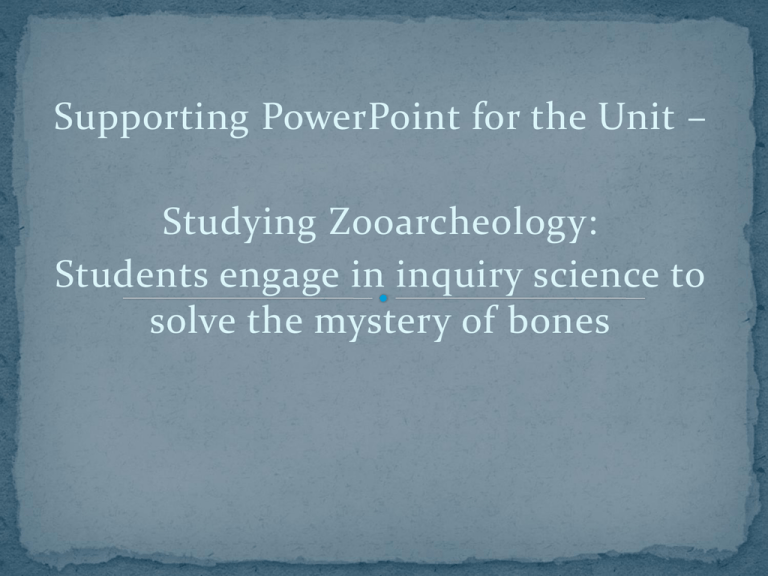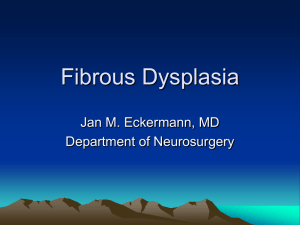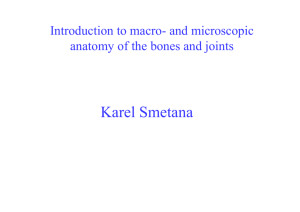PowerPoint
advertisement

Supporting PowerPoint for the Unit – Studying Zooarcheology: Students engage in inquiry science to solve the mystery of bones Zooarchaeology I. Introduction http://www.pics4learning.com/details.php?img=p1040701.jpg The hard parts of an animal can be bones, teeth and shells in which they lived! All of these can be used for decoration, clothing, and tools! http://www.nativelynx.qc.ca/en/histoire/iroquoiensphoto08.html www.uwlax.edu/.../earlycultures/images/bone2.jpg Archaeologists call garbage heaps MIDDENS http://www.labradorvirtualmuseum.ca/wem/midden.jpg Bones found at Fort Vancouver in July 2010 © 2010 Deborah Wolf Archaeologists at work Fort Vancouver, July 2010 © 2010 Deborah Wolf An archaeologist excavating. © 2009 Kate McCourt http://www.learnnc.org/lp/editions/occaneechiarchaeology-primer/1742 © 2009 Breanne Taylor Microsoft clipart http://etc.usf.edu/clipart http://en.wikibooks.org/wiki/Anatomy_and_Physiology _of_Animals/The_Skeleton http://etc.usf.edu/clipart http://etc.usf.edu/clipart Horse femur © 2010 Deborah Wolf Zooarchaeology Analysis Lab and Comparative Collection at Central Washington University http://www.cwu.edu/~anthro/zoo_lab.html http://www2.umaine.edu/anthropology/AnthroResearch.html http://www.richardgrubb.com/ZooArch.htm Use all your senses (except taste) to draw and describe the bone in the sketch area: Look for Modifications on the bone and record on the card. Visit the measuring table and records the weight and measure the length with your ruler. Measure and record the longest part of the bone. Plan about 10 minutes to finish the data card Research & Writings Bone Collections & Field Notes http://anthropology.chass.ncsu.edu Tests Observations You make a conclusion or judgment using reasoning and not based on direct observations. Thinking outside of the box is great! http://www.newscientist.com/gallery/dn17076-fossil-whale-bone-found-withshark-tooth http://www.boxvalley.co.uk/nature/sns/wad69/w69-05.asp http://www.boxvalley.co.uk/nature/sns/wad69/w69-05.asp Let’s record 3 Inferences You can answer: What could have happened to bring a large horse bone to a space under a bridge? Why does the bone look like that? Or?... What inferences are most likely? Bronze head of Roman Emperor Claudius found by a young boy at the River Alde at Rendham, near Saxmundham, Suffolk in 1907. http://www.britishmuseum.org/explore/highlights/highlight_objects/pe_prb/b/bronze_head_of_claudius.aspx longearsmall.com/mt/ Arabian Horse by Cecilia Medford at http://www.pics4learning.com/details.php?img=tara 1.jpg Marcus Aurelius ADE 180-192. Marcus Aurelius. Photograph. Encyclopædia Britannica Online. Web. 29 Jan. 2012. http://www.britannica.com/EBchecked/media/123475/Bronze-equestrian-statue-of-the-emperorMarcus-Aurelius-Piazza-del. Research & Writings Bone Collections & Field Notes http://anthropology.chass.ncsu.edu Tests Observations What did you learn in today’s lesson? How can what you learned be used during the school year? ? Vasquez, J. A. (2008). Tools and traits for highly effective science teaching, k-8. Heinemann Educational Books. Various images from stock photos and Microsoft clip art galleries. Lesson plan inspired by: Rubino, Dareth L. and Hanson, Deborah (2009) CSI for trees. Science and Children, NSTA. You are welcome to adapt these slides for your own use in an educational setting.











